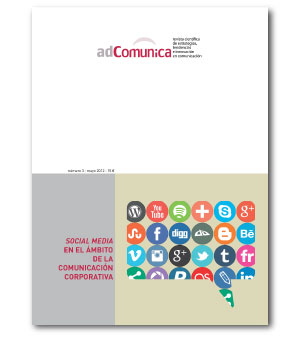Claves para la participación y generación de contenido en las redes sociales: estudio de caso del Museo del Prado en Facebook.
Contenido principal del artículo
Resumen
La presencia en las redes sociales, como parte de la estrategia de comunicación, es ya incuestionable para la mayoría de empresas e instituciones. El reto para estas organizaciones se centra ahora en saber cómo hay que estar y comunicar en la red. Facebook y el resto de redes nacen como un espacio para amigos y conocidos donde compartir, de una manera informal, temas de interés. En este espacio tan atípico, las redes irrumpen para romper con una comunicación tradicionalmente unidireccional. Los museos, que son el objeto de estudio de es trabajo, hasta el momento sólo situaban sus acciones únicamente en el campo tradicional de la comunicación institucional, un ámbito donde la información ha prevalecido por encima de la comunicación, y donde ofrecer datos ha estado por delante de otros objetivos comunicativos. Sin embargo, en las últimas décadas, los museos han realizado un importante esfuerzo por sumarse e incorporar las herramientas de la comunicación 2.0 como parte de una nueva filosofía, donde el museo es un actor activo de la vida social y cultural. Así, este estudio quiere avanzar en el análisis de la comunicación que se realiza en las redes sociales desde el análisis de contenido y el diálogo, y fundamentalmente sobre dos variables: la generación de contenidos y la participación equitativa, es decir, en igualdad de condiciones para los interlocutores, una plena bidireccionalidad. Al tratarse de una investigación poco desarrollada, la metodología elegida para el análisis es el estudio del caso. A raíz de la elaboración de una plantilla de análisis de contenido específicamente creada para este caso se analiza el muro de Facebook del Museo del Prado durante quince días.
Descargas
Detalles del artículo
1. Política propuesta para Revistas que ofrecen Acceso Abierto
Los autores que publican en esta revista están de acuerdo con los siguientes términos:
- Los autores conservan los derechos de autor y garantizan a la revista el derecho de ser la primera publicación del trabajo al igual que licenciado bajo la licencia CC BY-SA, que permite a otros compartir el trabajo con un reconocimiento de la autoría del trabajo y la publicación inicial en esta revista.
- Los autores pueden establecer por separado acuerdos adicionales para la distribución no exclusiva de la versión de la obra publicada en la revista (por ejemplo, situarlo en un repositorio institucional o publicarlo en un libro), con un reconocimiento de su publicación inicial en esta revista.


